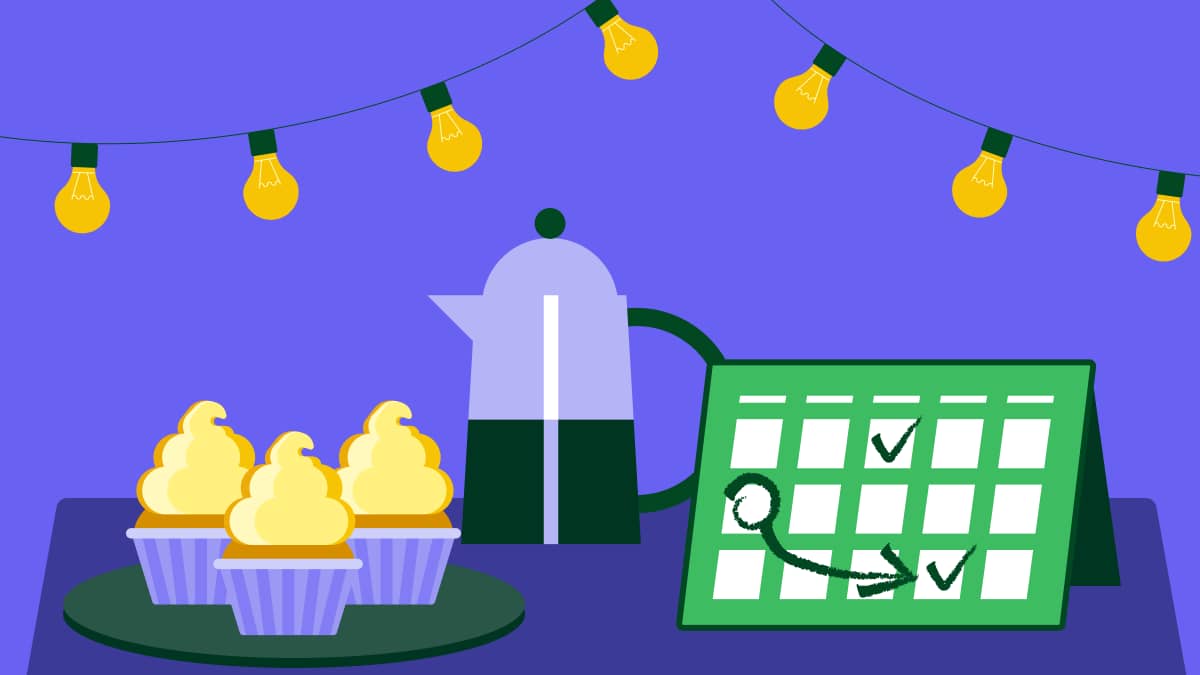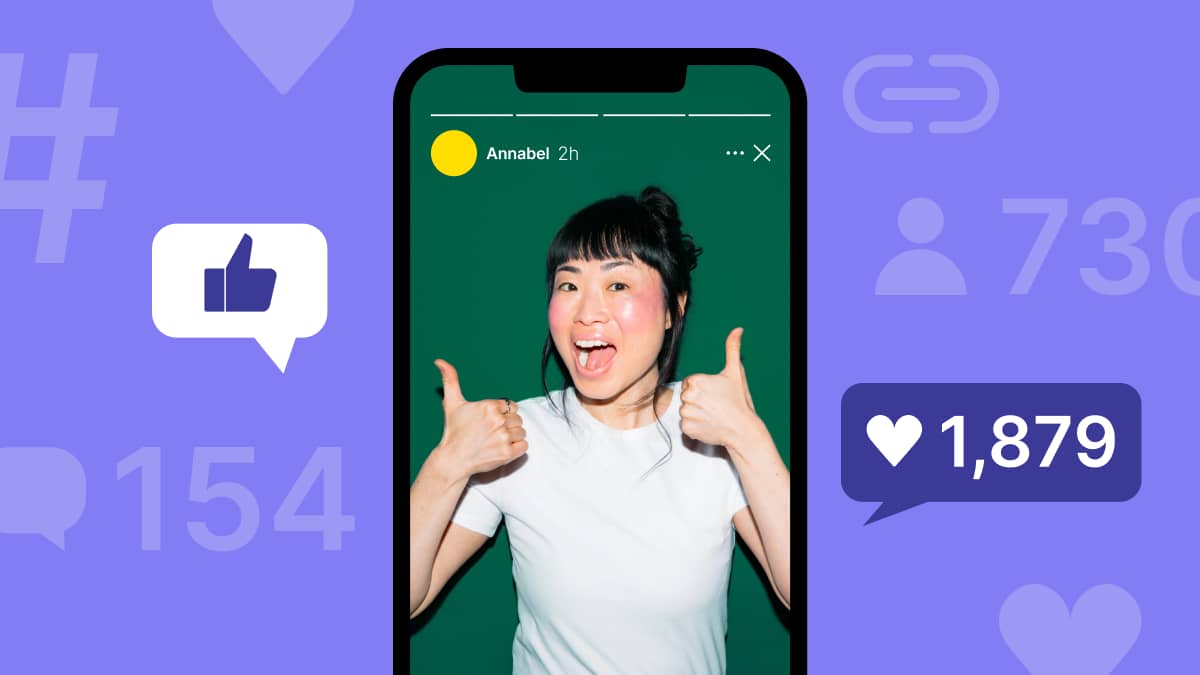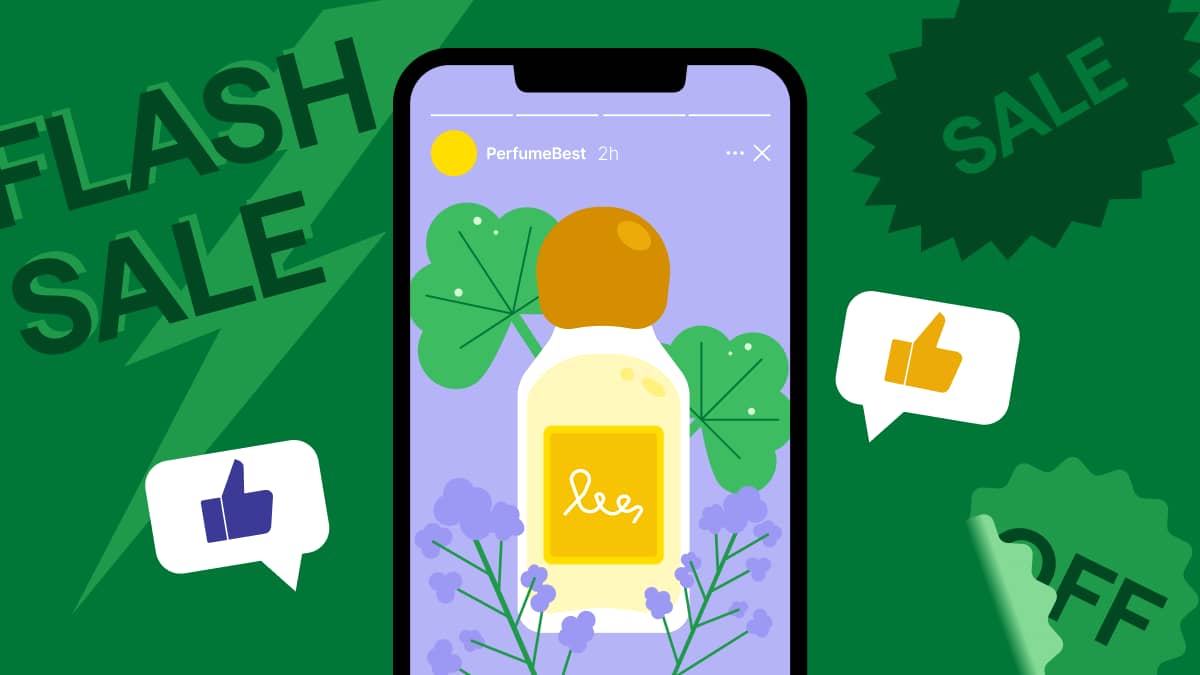Events are one of the best ways to get personal with potential customers, but you need a solid plan to get people to show up.
Effective event marketing is your playbook for promoting the event, filling every seat and creating genuine sales leads.
In this guide, you’ll learn how to make the most of your event marketing. You’ll discover how to build hype before your event and turn that energy into a packed sales pipeline.
Key takeaways for event marketing
Event marketing is promoting an event to fill seats and meet potential customers.
Brands use event marketing to turn in-person conversations into sales opportunities.
A strong event marketing plan covers how to promote the event, capture leads on the day of the event and follow up to close deals.
Pipedrive’s CRM helps you automate lead capture and follow-up, so you can nurture every prospect. Try Pipedrive free for 14 days and close more sales from your next event.
Event marketing definition: Event marketing promotes a brand by hosting or participating in an event.
It’s the entire process of communicating with your audience before, during and after the event to drive attendance and ensure it delivers a return on your investment. The goal is to engage customers and generate leads.
Marketers use different types of events to achieve specific business goals. Here’s a look at the most common events and why they’re valuable for your business:
Types of events | Why they matter for your small business |
Webinars and virtual events | Webinars generate leads at a low cost. You can educate a large audience and establish your company as a thought leader in your industry. |
Trade shows and conferences | These events put you face-to-face with your target demographic. They’re ideal for capturing high-quality leads at your brand’s pop-up and generating sponsorships. |
Workshops and in-person training | Live event training delivers hands-on value, which builds trust. It’s perfect for demonstrating a complex product or upselling features to existing customers. |
Product launch events | Launches create a surge of excitement and media attention around your new product. They help you drive initial sales and build market momentum. |
Local meetups and seminars | Smaller, casual events build a stronger community around your brand in specific regions. They’re great for nurturing personal relationships with key customers and prospects. |
The right event management plan turns event attendees into leads and customers. It builds a connection with your audience that a simple ad or email can’t match.
A quick example: Pipedrive’s webinar series
Pipedrive’s webinar program is a textbook example of how to turn educational content into highly qualified sales leads.
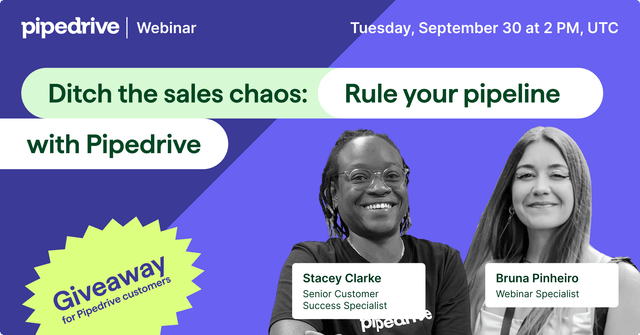
Here’s what Pipedrive’s marketing schedule generally looks like:
Before the event. Pipedrive advertises the webinar on sites like LinkedIn, using problem-focused titles to get the right people interested. Users sign up through a form, which gives Pipedrive their contact details.
During the event. Pipedrive’s team gives practical tips and shows how their tool solves the problem. They also hold a live Q&A session to answer audience questions.
After the event. A recording is posted on the Pipedrive website so people can watch it anytime. The company also sends follow-up emails to everyone who registered.
This model shows effective event marketing through a series of digital events rather than one large-scale conference or trade show.
Another example: Adobe MAX conferences
Adobe hosts an annual conference called Adobe MAX, which is a masterclass in building community and generating excitement through experiential marketing.
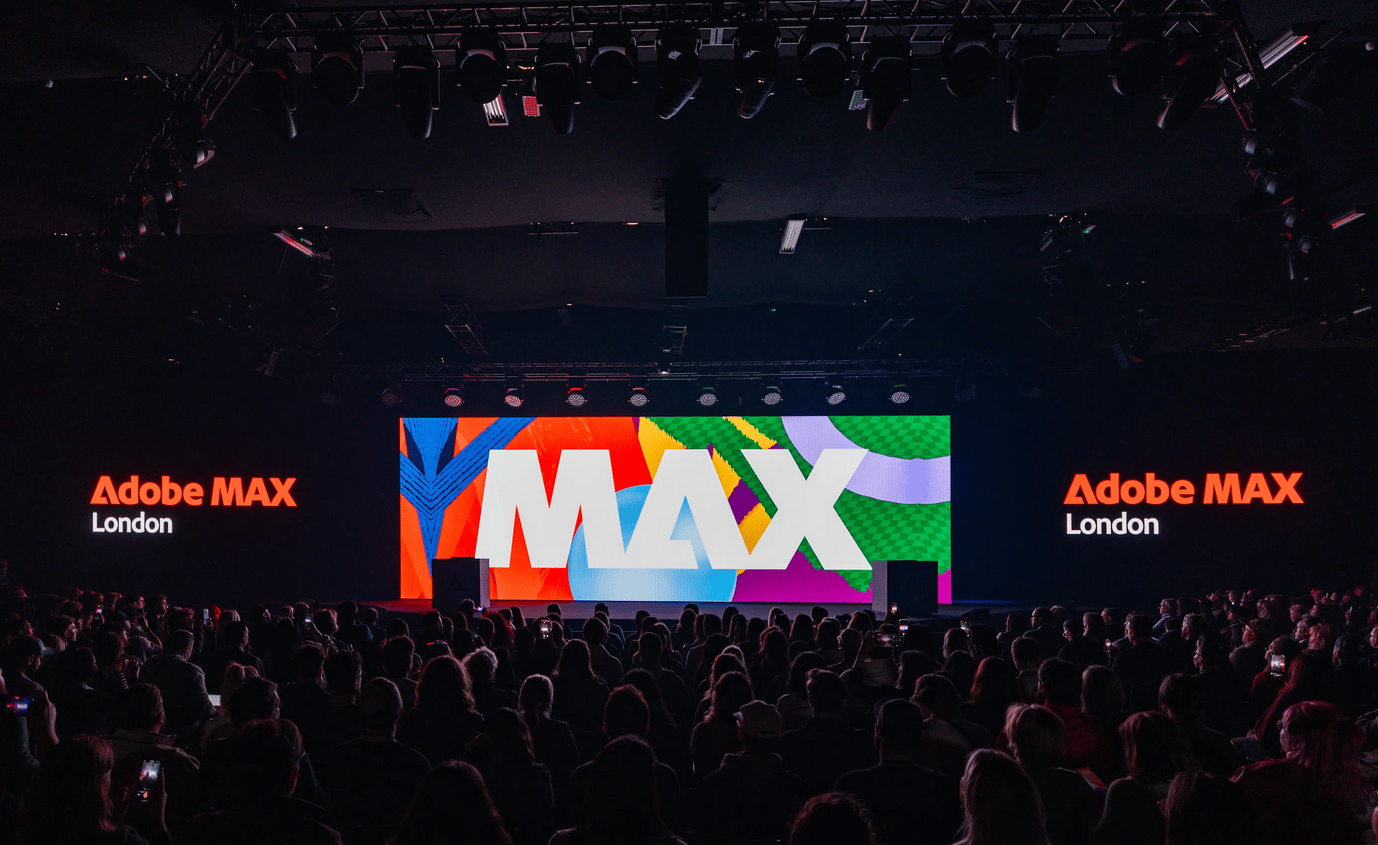
Here’s a look at Adobe’s marketing schedule:
Before the event. Adobe starts building hype months in advance. The company announces keynote speakers and launches engaging social media campaigns. It also starts creative contests to get the audience and influencers involved early.
During the event. The conference is an immersive hybrid event. It uses a mobile app for schedules and hosts hands-on training workshops. Adobe live-streams the main keynotes to include a global audience that couldn’t attend in person.
After the event. Adobe uploads session recordings for on-demand viewing. It sends out highlight reels and post-event surveys, and uses themes from the event to guide its content marketing for future events.
Adobe’s strategy makes MAX a conference that inspires and energizes its user base.
How to create an event marketing strategy in 4 steps
A solid event marketing strategy ensures that every dollar you spend contributes directly to your sales pipeline.
These four steps will guide you through the event lifecycle, from planning to measuring your final ROI.
1. Pre-event planning: laying the groundwork for a high ROI
Your goal before any event is to get the right people to show up on the day.
Success hinges on choosing the best promotional plays for your audience.
Before you send an email invitation, there are a few things you need to do:
Define some specific, measurable marketing goals (e.g., book 20 qualified meetings or register 150 webinar attendees)
Identify the ideal customer profile you want to attract or meet
Set a clear budget for your promotional activities, including any ad spend
If you have those basics covered, you can start building your strategy. Once you have a shortlist of promotional methods, compare what each one offers.
Here are some key approaches to consider:
Marketing channel | Why it works |
Email campaigns are an easy way to drive registrations for events where a large audience is the main goal. It’s the most direct way to reach your existing contacts. | |
Targeted social media ads | Ads let you reach a highly specific new audience. Use platforms like LinkedIn to find potential attendees based on their job titles, industries or professional interests. |
Partnership marketing (or co-marketing) | Brand collaboration with another relevant, non-competing company gives you a warm introduction to its audience. It adds credibility and can expand your reach. |
One-to-one marketing | Direct marketing is an effective way to secure meetings with high-value targets at your event. A well-researched message shows you’re serious about connecting. |
Here are some tips to get the most from these methods.
When running email campaigns, don’t rely on a single announcement. A sequence that builds from awareness (“We’re excited to announce…”) to urgency (“Last chance to register!”) is more effective.
If you’re using social ads, target people who follow the event organizer’s company page on LinkedIn and use the event’s official hashtag to join the online conversation.
Likewise, if you decide to work with a partner, make it as easy as possible for them to promote you. Give them a promo pack with pre-written email copy, social media posts and images.
The best strategies blend these methods. When you mix channels, you create multiple touchpoints and can reach your ideal attendees in different contexts.
How Pipedrive can help turn strategy into action
A customer relationship management (CRM) system makes executing these marketing strategies much easier.
Pipedrive’s Campaigns add-on gives you tools to run a professional email campaign that drives registrations.
Use a three-part email sequence to build interest and urgency:
Announcement. Include details about the event (what, when, where), the key benefit for attendees and a clear call-to-action to register.
Value add. Send a follow-up email that shares more value, like a speaker spotlight or the session agenda.
Final reminder. Finish with a short, urgent email sent a day or two before the event (or before early-bird pricing ends) to drive last-minute decisions.
To build your sequence, go to the Campaigns tab in the main menu and click “+ Campaign” to open the email builder.
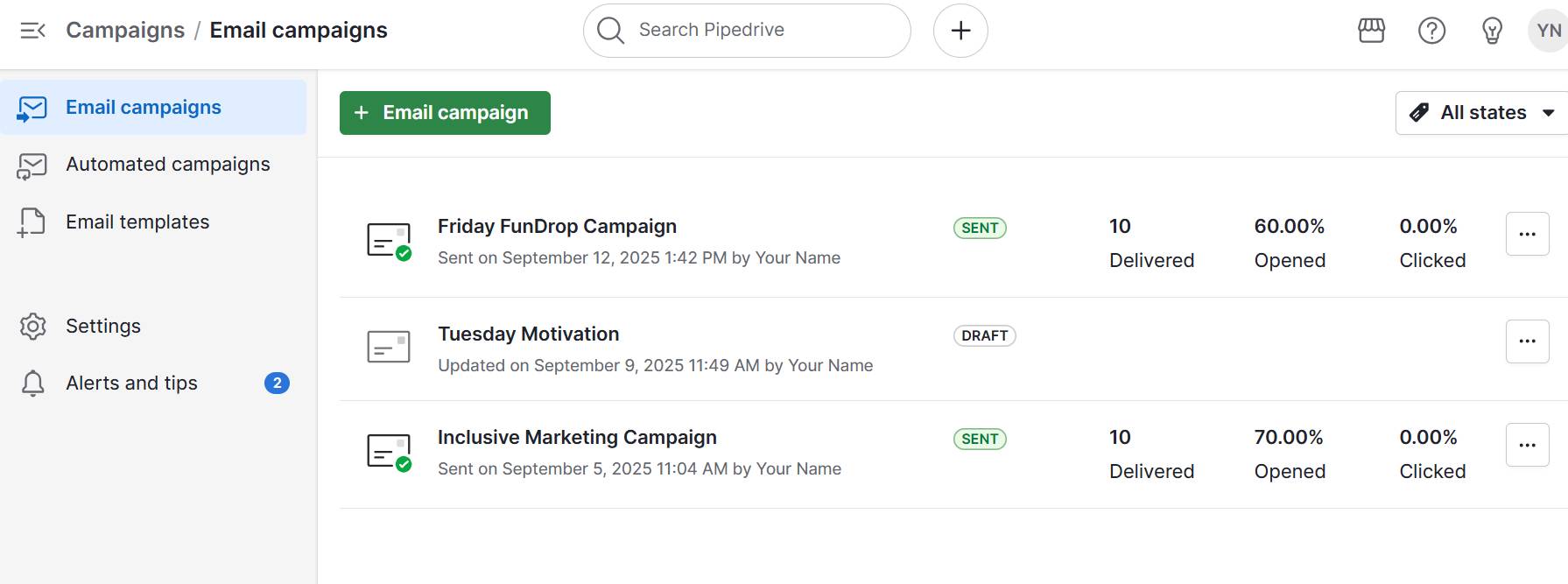
Now, use Pipedrive’s AI email writer to draft the copy for your announcement email. In the editor, select the “AI writer” icon in the toolbar.
Give it a simple prompt about your event to generate a strong first draft quickly.
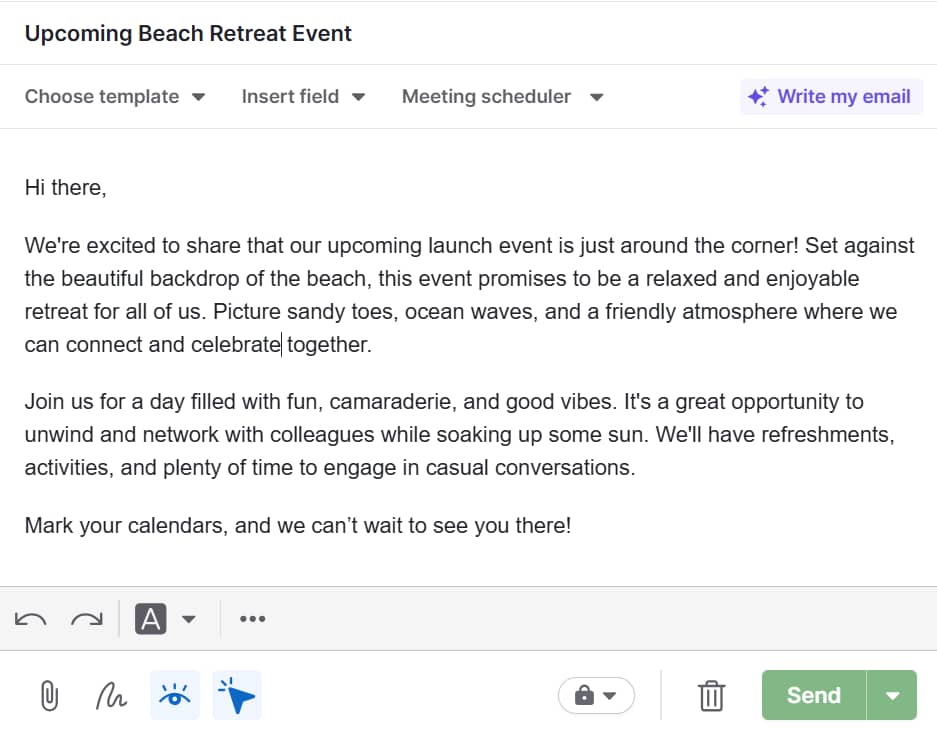
Next, edit your draft as needed and go to the Recipients section and choose the filtered email list you want to target.
Rather than sending it immediately, schedule the campaigns to send at a specific time that’s best for your audience.

When the first campaign is complete, return to the Campaigns dashboard and create your value-add email.
Update the copy and schedule it for a few days after the first one. Repeat the process for your final reminder email to complete the sequence.
2. During the event: making every conversation count
The pre-event plan gets people in the door, but the sales conversations you have on the day drive sales revenue.
The event itself can be chaotic, with many booths and brand activations. You need event marketing tools to cut through the noise and find the best sales opportunities.
Your team’s on-site success comes down to a few core event strategies:
Use a digital lead capture system and ditch the business card fishbowl
Ask questions to qualify leads before you start pitching
Focus on the quality of conversations, not the quantity
End every promising conversation with a clear and agreed-upon next action
The biggest mistake teams make at events is inconsistent lead generation.
When one person writes notes, another collects business cards and a third sends themselves emails, leads will fall through the cracks.
The solution is having a single event platform your team uses for every lead. It could be your CRM’s mobile app or a simple QR code at your booth that directs visitors to a lead form or landing page on your event website.
Here’s an example of what this looks like in practice:
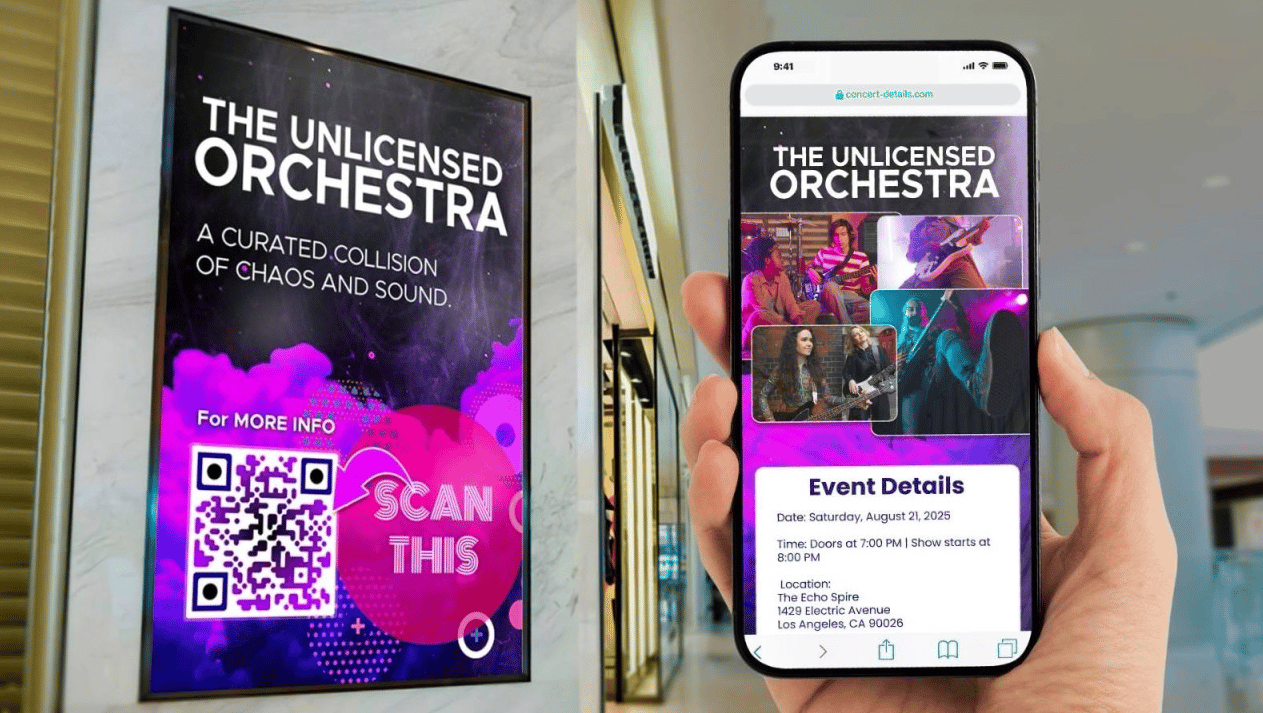
A unified system means you capture leads in the same way. They’re ready for immediate follow-up as soon as the event is over.
Once your capture system is in place, you can focus on the quality of your conversations. The goal is to determine if a prospect is a good fit as quickly as you can.
Asking a few targeted questions can help you qualify leads on the spot. Here are some simple discovery questions to guide your discussions:
Goal | Example question |
Uncover a need | “What’s the biggest challenge your team faces right now with [their area of work]?” |
Understand the timeline | “What does your timeline look like for finding a solution to [their challenge]?” |
Identify authority | “Who else on your team is usually involved when you look at new tools or services?” |
The answers to these questions are gold. Capture them as notes in your CRM. This context allows you to send a personal and relevant follow-up message instead of a generic template.
Finally, never end a good conversation with a vague “we’ll be in touch”. A strong conversation always ends with a concrete next step you both agree on. It turns a casual chat into the first stage of your sales process.
How Pipedrive can help automate lead capture
A successful on-site lead workflow includes three quick actions that vastly improve the event experience for marketers:
Scan business cards. Capture a new prospect’s contact information in the moment.
Add qualifying notes. Record the answers to your questions for personalized follow-up.
Tag leads. Apply a unique label to group your event contacts for easy tracking later.
Pipedrive’s mobile functionality lets you digitize every conversation as it happens.
To manage your conversations at the event, open the Pipedrive mobile app. From the main menu, select “Contact scanner” to record a prospect’s details using your phone’s camera.

After scanning, Pipedrive creates a contact.
Before you save it, scroll down to add notes and apply a specific event label to keep everything organized.
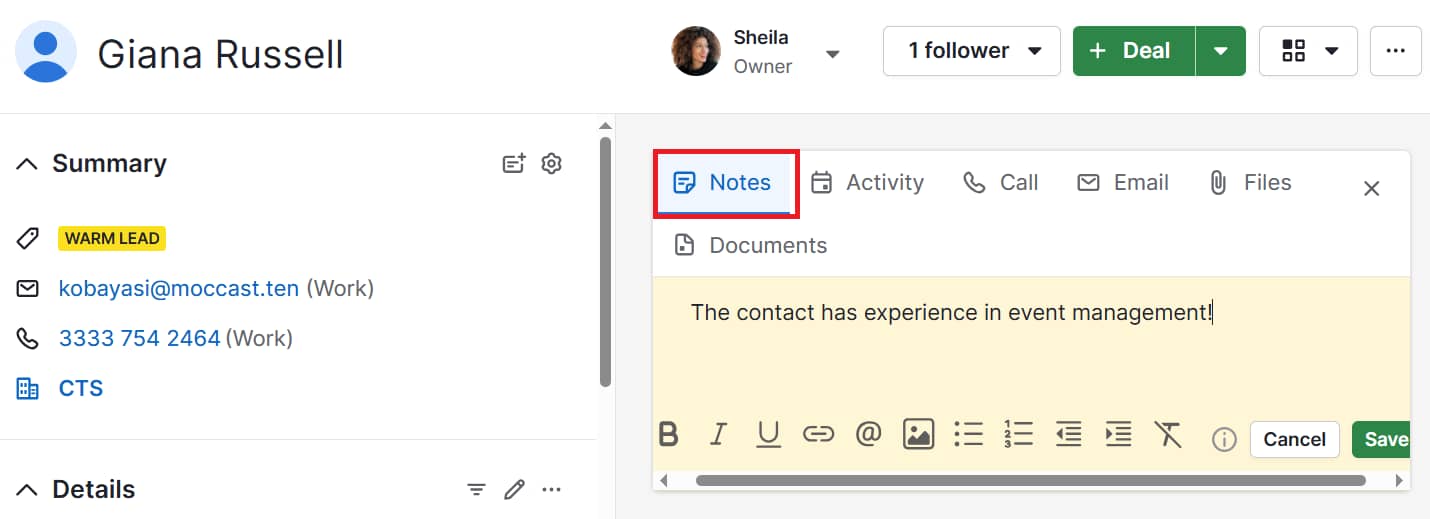
Finally, if you agree on a next step during your conversation, schedule it immediately.
In the new contact’s profile, choose “Add activity” and create a follow-up task.
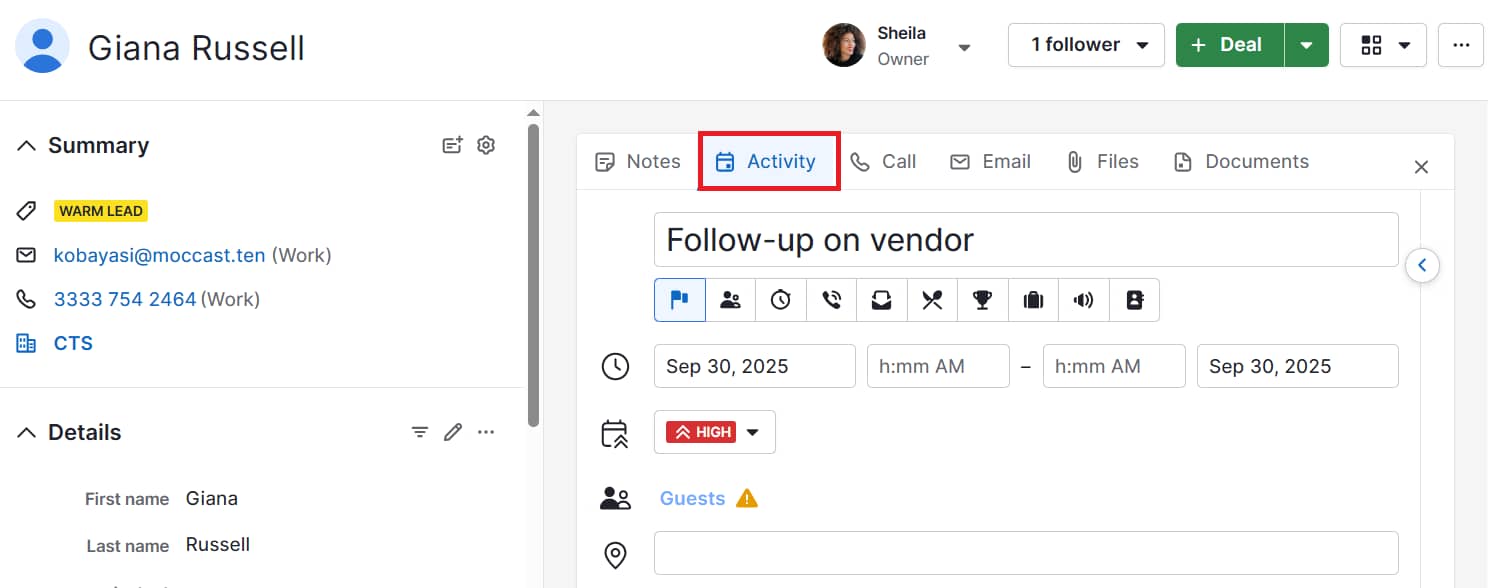
For a more hands-off approach, create a Web Form (you’ll need to add the LeadBooster feature to your plan).
Go to the Leads tab and select “Web Forms > New Web Form”.
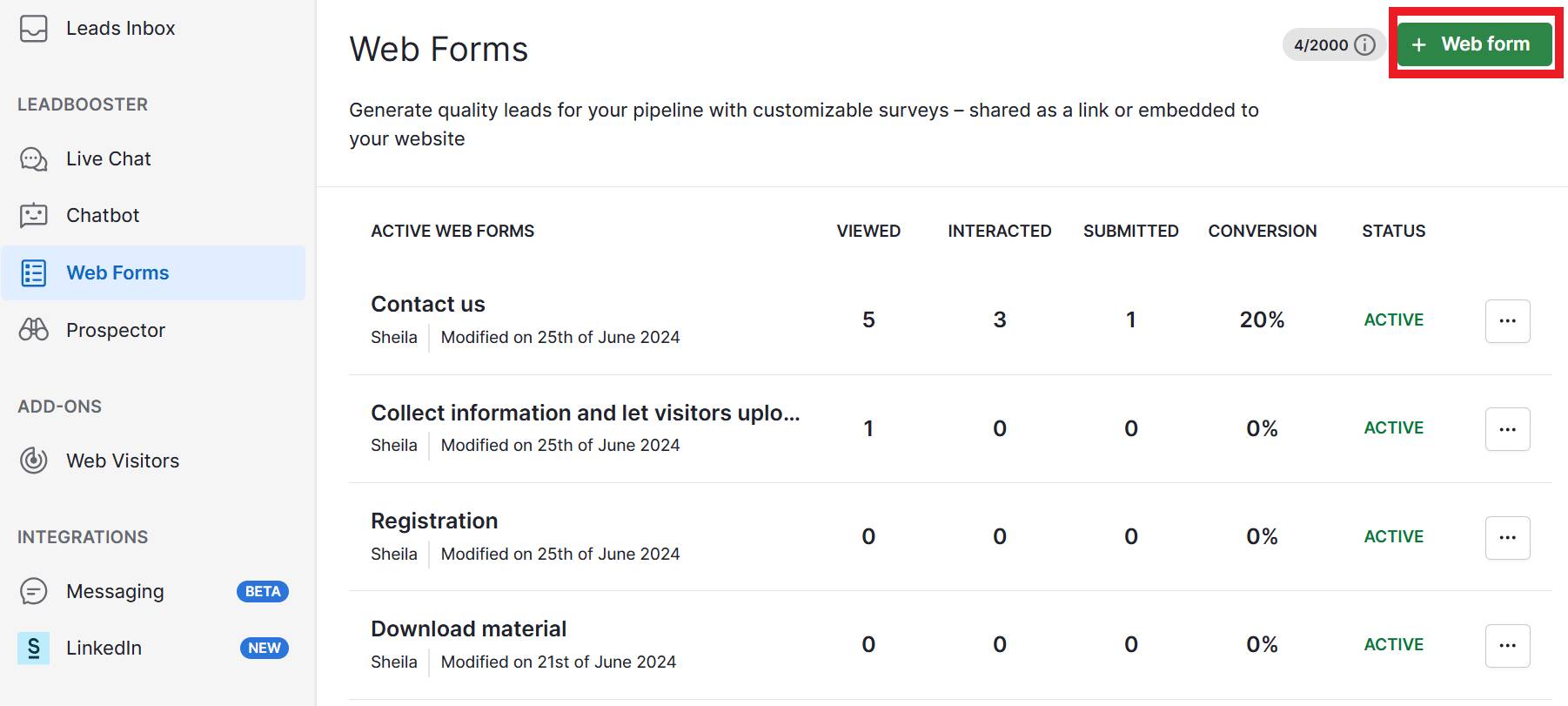
Choose “Registration” and set up important fields in the form builder. When you’re finished, use a free online tool to turn your form’s URL into a QR code for visitors to scan.
3. Post-event follow-up: turning conversations into customers
The conversations at an event get you in the door, but you need a solid follow-up strategy to convert prospects into customers.
An effective follow-up strategy should look something like this:
Act within 24 hours to stay top-of-mind
Personalize your outreach by referencing your conversation
Segment new leads based on their level of interest
Nurture contacts who aren’t ready to buy immediately
Speed is your greatest advantage. The enthusiasm from a great conversation fades quickly, so sending a prompt email the next day shows you’re organized and keeps the momentum going.
Your email also needs to be personal. Avoid sending a generic “Thanks for visiting our booth” blast to everyone.
A better approach is to segment leads into tiers based on the notes you took at the event. For example, you can group your new contacts into hot, warm and cool leads:
Lead quality | Who they are |
Hot leads | Highly interested people who asked for a sales demo or meeting. Email them within hours to schedule that next step. |
Warm leads | Qualified leads with a longer timeline. Send them a personal email that references your chat and gives relevant information (like case studies) about what interested them. |
Cold leads | Contacts you scanned but barely spoke with. Add them to a general, automated email nurture campaign to track their engagement over time. |
Here’s what it looks like to label your contacts in Pipedrive’s CRM:
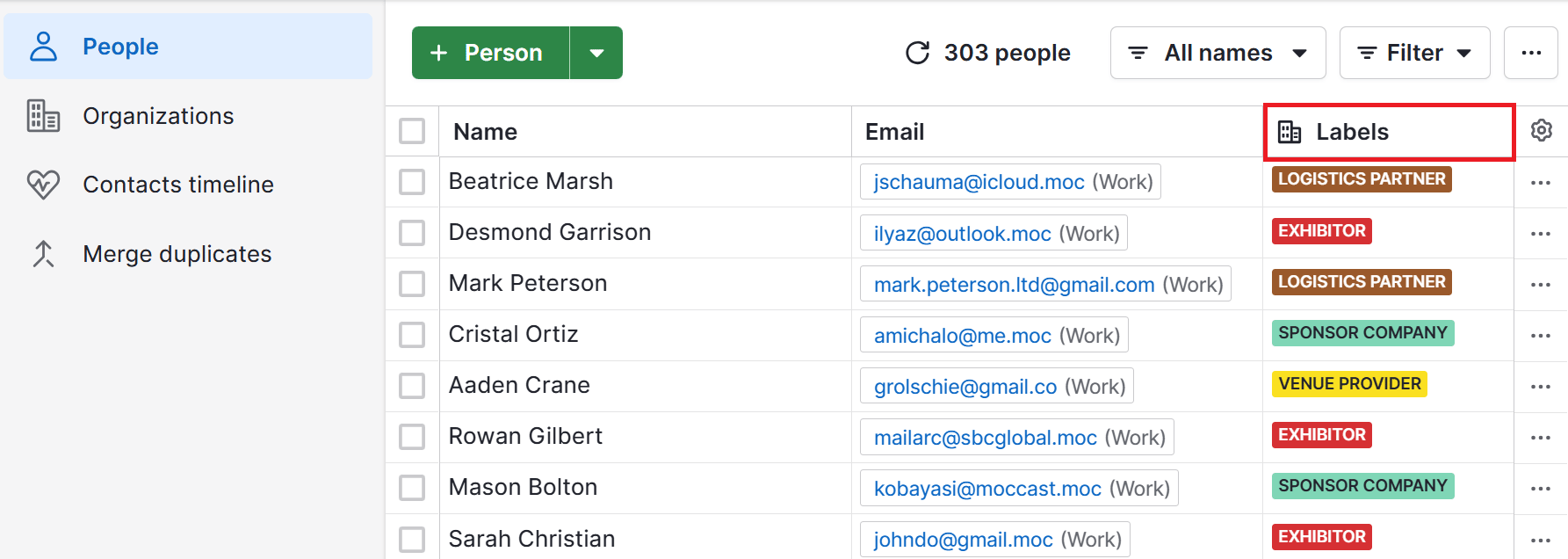
For your hot and warm leads, mentioning a detail from your chat makes a huge difference. A simple reference separates your message from the dozens of other follow-ups they’ll get.
Remember that most leads from an event aren’t ready to buy immediately. Don’t discard them if they don’t reply to your first email.
Entering your warm and cool leads into a long-term nurturing plan helps build brand awareness. When they’re ready to make a decision, you’ll be the first person they think of.
How Pipedrive automates your post-event follow-up
Pipedrive’s automation tools let you segment your new contacts and send the right message as soon as possible.
Here’s how Pipedrive helps with each step of your follow-up strategy:
Creating email templates. Prepare personalized messages in advance to save time.
Building automations. Trigger emails and tasks for your hottest leads.
Segmenting event leads. Use filters to create hot, warm and cold email lists in real-time.
Launching nurture campaigns. Keep in touch with your long-term prospects.
To get started, write your messages in Pipedrive. Go to Company settings and select “Email templates”.
Create templates for your hot and warm leads, using merge fields to add personalization.
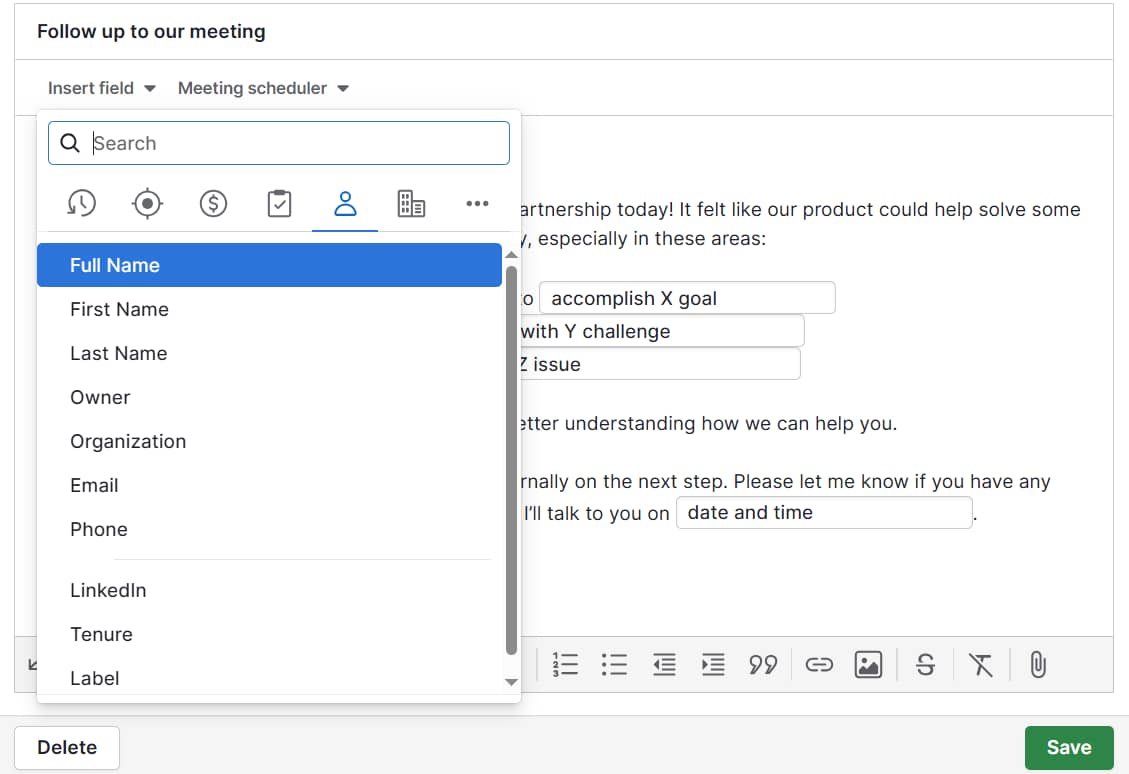
Go to the Workflow Automation tab to build your workflow.
Set the trigger for when Pipedrive creates a new contact and add a condition that the person must have your event label, like “Q4 Summit 2025”.
Add an “If/else condition” that checks the person’s labels.
Set the condition for the “Yes” branch to be “Person > Label > is > Hot”. The “No” branch will apply to warm leads.
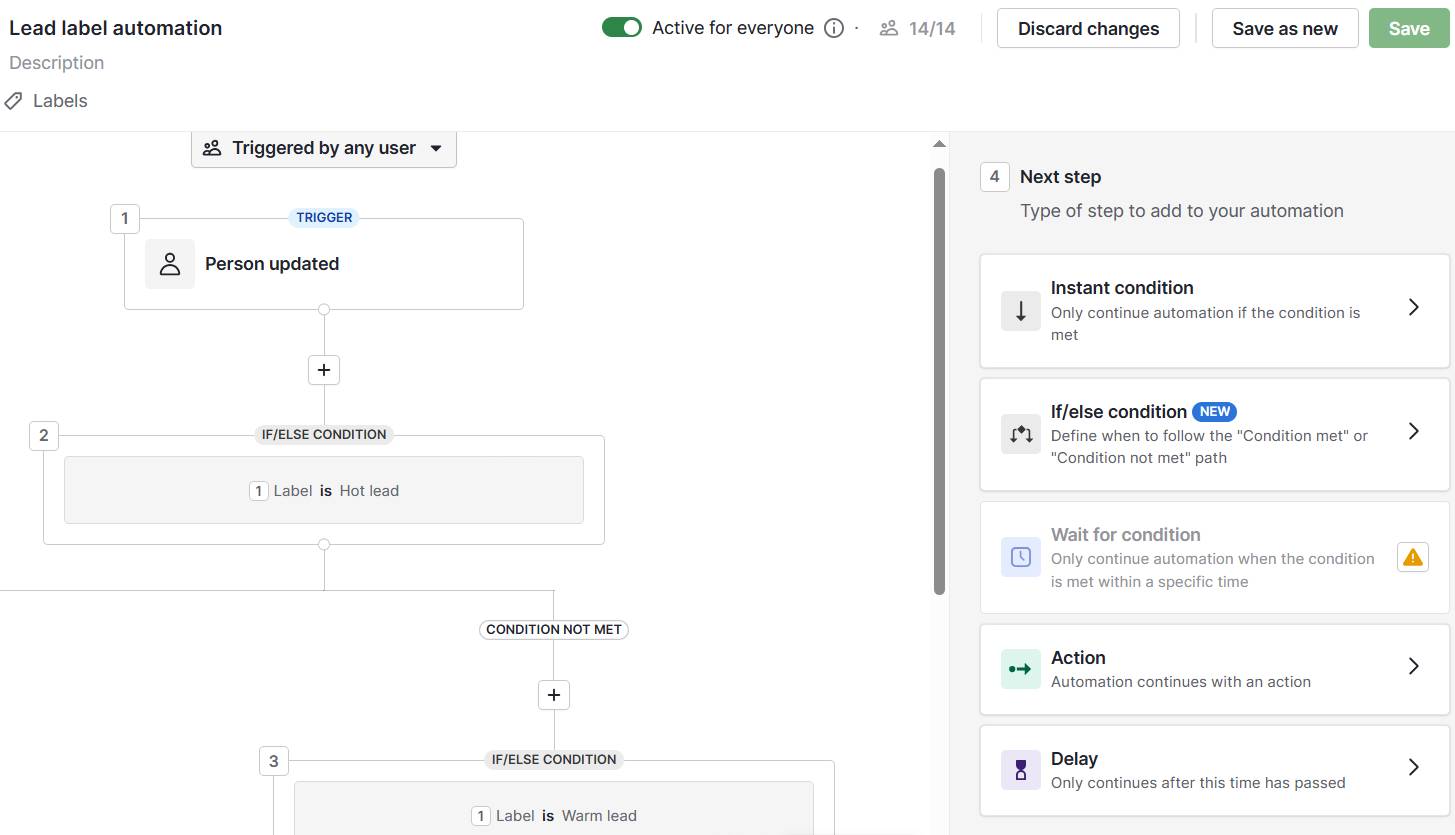
Last of all, assign the correct email to each branch.
In the “Yes” branch, add an action to send your hot lead template. In the “No” branch, add an action to send your warm lead template. Pipedrive will send the right follow-up based on the label your team applied on-site.
You can build automations for each segment based on their event label – one for hot leads, another for warm – and trigger personalized follow-ups automatically. For a more in-depth look at Pipedrive’s Automations, check out the video below.
4. Measuring your success: calculating true event ROI
Tracking your event ROI lets you measure the financial impact of your efforts as new leads move through your sales pipeline.
The trick is to use the contact labels you created for each lead during the event. These tags let you filter your main pipeline to see only the deals from that specific event.
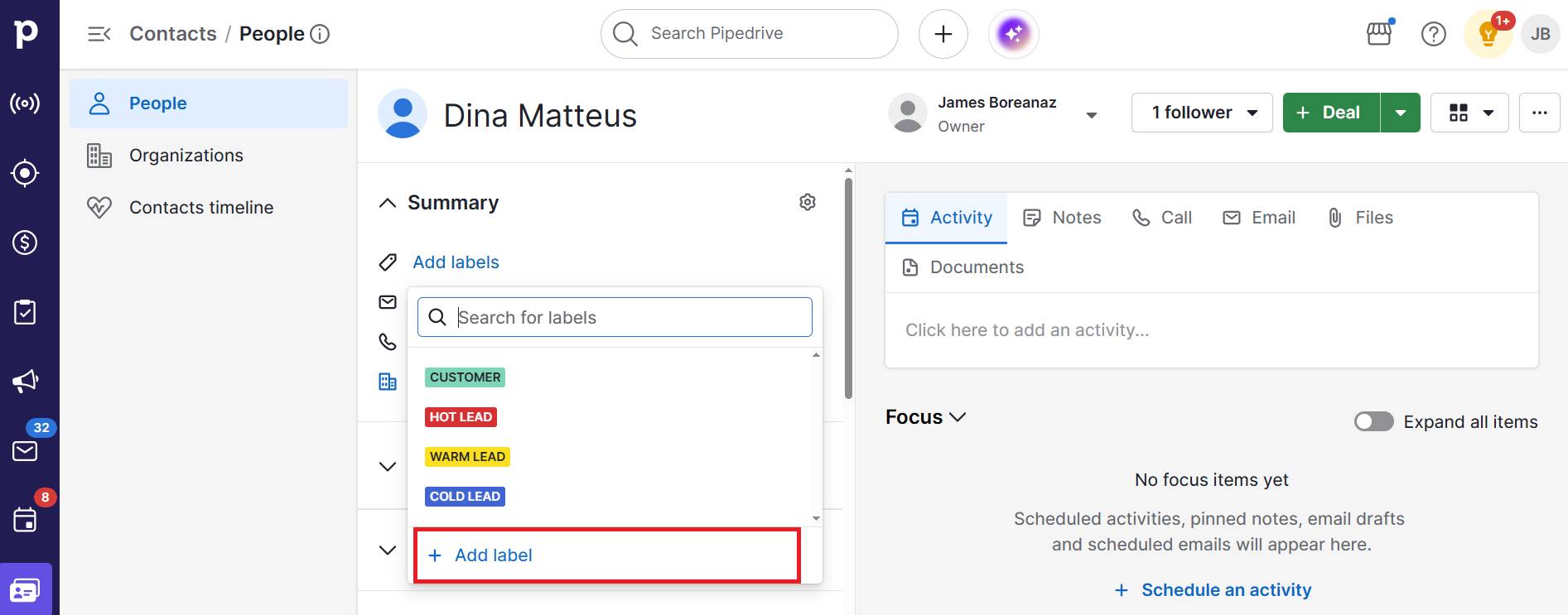
You’ll see your event leads’ performance in real-time. You can track the number of deals and their combined value, separate from all your other sales activities.
Use this data to work out your ROI and report your marketing results to stakeholders.
To calculate your ROI, you first need the total event cost. Make sure you include all expenses for an accurate result.
The formula for ROI is the total revenue minus the event cost, all divided by the cost.
For example, say the event cost $5,000 and you’ve closed $20,000 in deals. Your current ROI is ($20,000 − $5,000) / $5,000 or 300%.
The best way to monitor these numbers is with a dedicated sales dashboard that pulls all your key event marketing metrics into a visual report.
Your sales dashboard should show your total leads, pipeline value, deal win rate and total revenue closed from the event. It gives you a live look at the event’s ongoing performance.

With this detailed context, you can optimize your next event’s digital marketing efforts.
How Pipedrive improves your event reporting capabilities
A CRM gives you the hard data to track your sales KPIs and prove an event’s value.
Pipedrive’s reporting tools track every deal from your event to calculate your ROI.
To start, you need to see all the deals from your event. Go to the Deals view and filter deals for your event label.
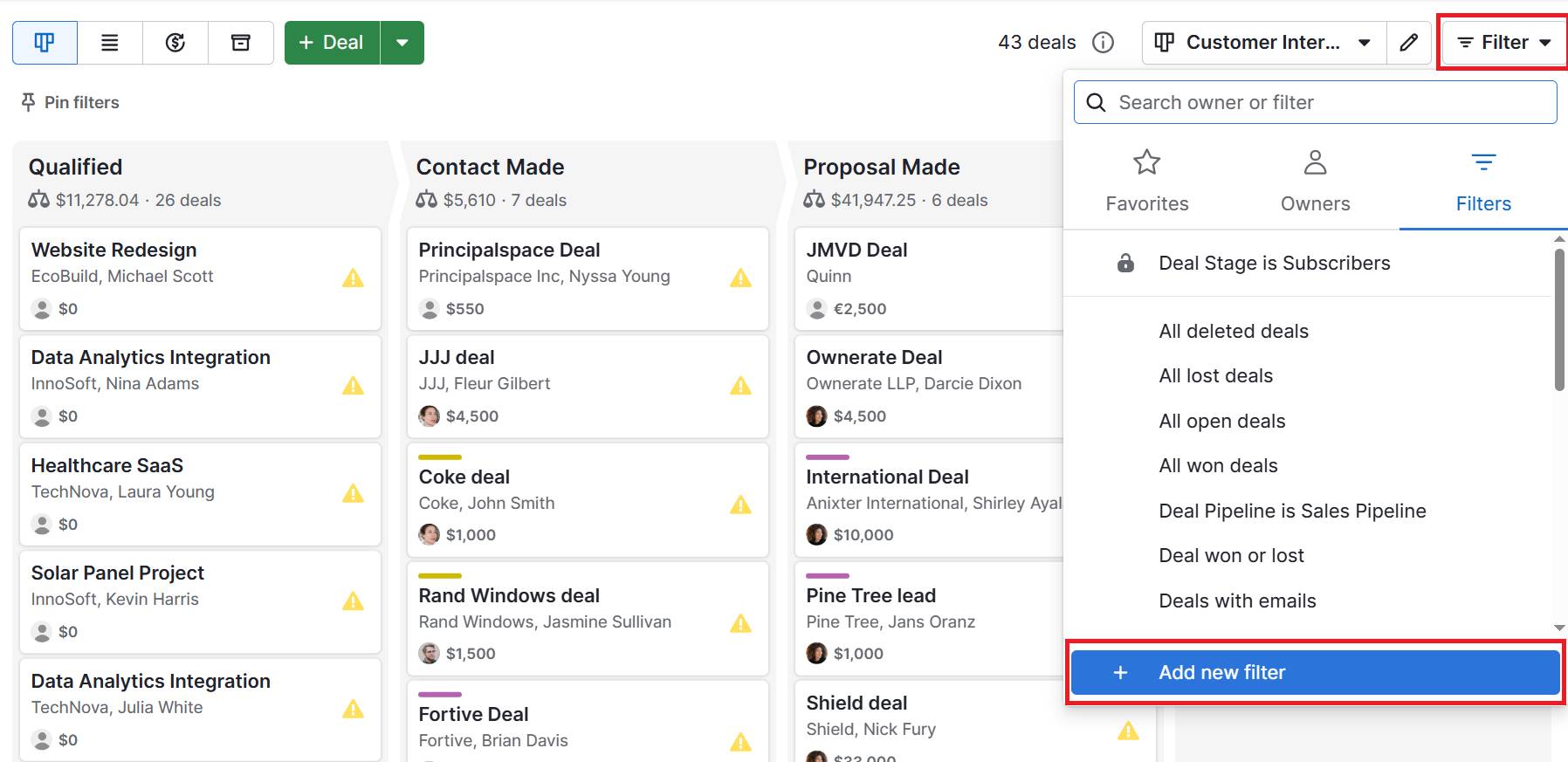
Next, go to the Insights tab, click the “+” icon and select “Dashboard”. Give your new dashboard a clear name to create a space for all your event reporting.

Inside the dashboard, click “+ Add report”. Choose a Deals started report to see the total number of leads and pipeline value from the event.
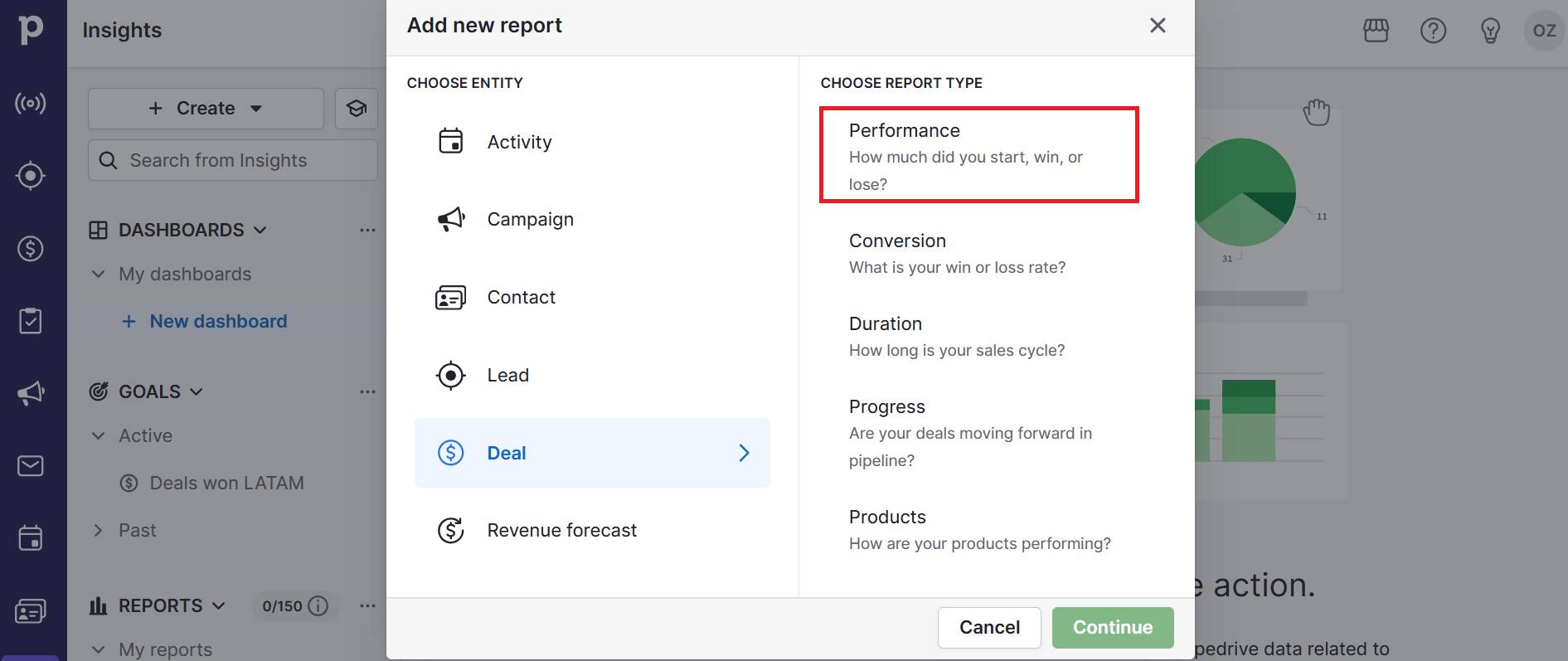
Add another report to your dashboard, this time for Deals won. This report will show you the total revenue you’ve closed from the event.
Use the live data to calculate your ROI. Take the total revenue from your “Deals won” report and apply the formula above to get your ROI percentage.
Download Pipedrive’s general event checklist template
4 advanced tactics to maximize event conversions
Once you have the fundamentals of event marketing down, you can use additional tactics to stand out from the crowd.
Here are four event marketing best practices top performers use to make the most of every event:
Advanced marketing tactic | Why it maximizes conversions |
1. Host an exclusive side-event | Something like a private dinner for your top prospects creates a relaxed environment away from the noisy event. It makes your guests feel valued and gives your sales team uninterrupted time to build relationships. |
2. Secure a speaking slot | Presenting on a panel or hosting a workshop positions you as an industry expert. It builds massive credibility and attracts a pre-qualified audience already interested in your expertise. |
3. Run a pre-event reconnaissance campaign | If it isn’t your event, use LinkedIn and the event’s agenda to find leads that match your target audience profile weeks in advance. Sending hyper-personalized outreach to book meetings before the event starts means you’ll spend the time in high-value conversations. |
4. Create a targeted post-event content piece | Create a valuable report like “The top 5 takeaways from the summit”. Sending this to new leads reinforces your expertise and gives you a natural reason to re-engage them. |
Use these tactics to move beyond just attending events and start creating memorable experiences for your most important prospects.
Final thoughts
Successful events are a powerful way to generate revenue, and a solid event marketing plan is what turns conversations from the event floor into closed sales.
A sales CRM gives you the control to execute that plan at every touchpoint. It organizes your leads, automates follow-up and tracks results so you always know your ROI.
Try Pipedrive free for 14 days and see how it can streamline your event workflow and help you close more deals.
